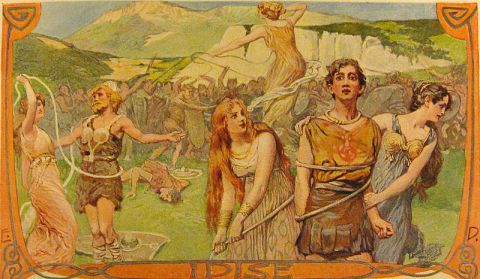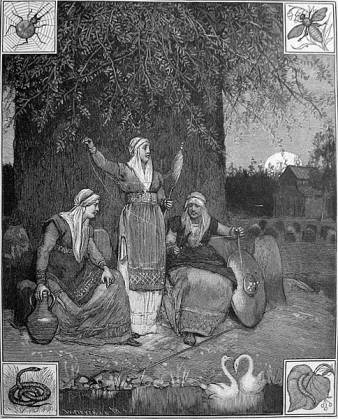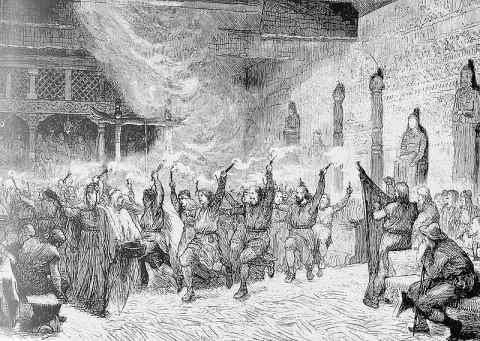A Dis is a female figure that people often associate with fate. Though there are no narratives specifically of the Disir, they appear in poems about the heroes. They are both protectors and harbingers of death.
Who are the Disir within Norse mythology? Disir are any female spirit or supernatural being. This includes the Fylgjur, the Hamingju, the Norns, the Valkyries, and even some goddesses. However, understanding their role throughout the myths can be hard because it is so broad.
What Are the Disir?

To define Dis or Disir, is difficult, but it roughly translates to “lady.” Additionally, some mean “goddess,” “spirit,” or to be the original word for the Valkyries. The term is related to terms of other languages, such as “itis,” which is old German, “ides,” which is old English, and “idis,” which is old Saxon. All of them can mean some kind of lady or supernatural female spirit.
Interestingly enough, the Disir does not interact much with the Gods, instead, they deal mostly with humans. In many of the stories, people believe the Disir belong to a family rather than an individual. This is a point that slightly separates them from the Fylgjur who most believe belong to an individual.
What Did the Disir Do?
What exactly did the Disir do? Again, that is a tough question. We already know the Dis are female ancestors who have died. These spirits are capable of aiding their kin in battle or looking after warriors who have already died, much like the Valkyries. With that said, they can be spiteful beings at times.
While it’s human nature to try and categorize certain beings as either good or bad, the Disir sometimes offer protection, but they can bring warnings, or threats, of impending death as well.
It’s the color of their clothing that tells the type of message they’re bringing. When seen on the battlefield or in dreams, they will usually be riding horses and wearing either white or black. If dressed in white, they will offer wards and defenses. If seen in black, though, then it might mean death and destruction are near.
There is also reason to believe the Disir are beings of fertility and childbirth. They will look after and protect a child who is from a family the Disir deem worthy. However, if a child is born into a family that they don’t deem worthy, they will bring ill will upon it.
The Disir in the Sagas, Poetic Edda, and the Grágás
Disir in the Sagas
The sagas are the main source for the Disir being a family spirit. These stories give us insight into how the Disir fit into the everyday life of the Norse people, though still in a mythological style.
The Volsungs Saga
For instance, in the Volsungs saga, Sigmund’s Disir protects him in battle until Odin himself comes and kills him.
Olaf’s Saga
Another saga shows that Disir might compete with one another. In the story Þiðrandi and Þórhall in Olaf’s saga, Flateyjarbók, after a Winter Night’s feast, Thorhallr gets a feeling that someone will die. Thidrandi informs him of his vision of nine women wearing black and nine wearing white. Then the women wearing black attack Thidrandi, who dies sometime later. Thorhall believes that what Thidrandi saw before his death was his family Disir battling over his fate, with those dressed in black winning.
Disir in the Poetic Edda

In the Edda, “Dis” commonly appears as, or describe other female beings outside of family spirits. The goddess Freyja is called “Vanadis“. An ice goddess, Skadi, is referred to as Ondurdis. Both the Norns, female beings who control fate, and Valkyries, shieldmaidens that guide warrior souls to Valhalla, consistently translate to “Disir.”
Hamðismál
In Hamðismál, the family Disir spirits convince brothers Sörli and Hamðir that they need to kill their brother Erpr. In the next stanza, “hounds of the Norn” refers to the Dis spirits, The term Disir in the poem often translates to Norns.
Grímnismál
Disir again translates to Norns in Grímnismál when Grimnir credits the “wrath of the disir” to his prediction of the death of Geirröðr.
One last connection with the Norns is when they show up at the birth of a child to tell its fate. The Norns here are possibly to be past female ancestors.
Reginsmál
We can see their relation to the Valkyries in the story Reginsmál. In it, Disir are watching over a warrior who is going to die in battle, something that is typical of the role of the Valkyries.
Helgakviða Hundingsbana
In Helgakviða Hundingsbana, the spirits of the women Svava and Sigrun are riding horses over a battlefield to ward Helgi. Those same Disir later protect his fleet through a storm so he arrives safely to shore.
The Greenlandish Lay of Atli
One story, The Greenlandish Lay of Atli, in the Edda seems more reminiscent of the Sagas. Glaumvör continuously has dreams of her husband, Gunnar, death, who keeps dismissing her. She tells him that dead women kept coming to choose him and that they were Disir. After hearing that, Gunnar believes that he can’t continue acting like his death is not coming soon. Shortly after, he does end up dying.
Disir in the Grágás
The Grágás is a medieval Icelandic law book. Its use started sometime in the 10th century and was eventually written down in the 12th century.
One code involving the dragonhead of a ship makes reference to spirits that sound like Disir.
A ship’s dragonhead offers magical protection for both the ship and crew. The main function of it is to ward off evil spirits. However, once the ship returns home, the dragonhead needs to be taken off so as not to intimidate their native spirits. The native spirits here sound like the Disir.
Worship of the Disir
The Disablot/Festival of Winter Nights

So, how did common Norse people pay homage to the Disir? A festival known as “Disablót” takes place every winter. A “blót” was a sacrificial ritual, so disablót translates to “sacrifice to the Disir.”
It is sometimes referred to as the Festival of Winter Nights because it takes place during the winter equinox. The hope of the sacrifice was to bring good fortune to one’s family.
Blóts are an important aspect of religious life for ancient Norse people and the Sagas mention them often. They could be held multiple times a year and worshippers could dedicate it to any god, goddess, spirit, or ancestor. People thought it brought them closer to the deity being they were worshiping like they were feasting directly with them.
Animals, mostly pigs or horses, would be used as sacrificial offering. Their meat would then be cooked and eaten at the festival. The blood of the animal was used to cover the statues of the gods and the people at the festival.
The Disablót is a feast to worship and honor the Disir, hopefully bringing goodwill towards the family holding it. A special hall may have been used for the festival called the disasalr, hall of the disir. Sometimes women perform the ritual, rather than men. The reason for this was to have a closer connection to the female spirits being praised.
The feast itself wasn’t typically held as a large public event. Instead, it was an intimate household affair that involved only family and close friends. There was a larger occasion that involved more people for the honoring of the Disir.
The Disting
A coinciding event of the Disablót was the Disting, a market or fair. Unlike Disablót, the Disting involved people from all over, rather than just family and close friends, coming together to honor their female ancestors. It was also held alongside the Thing, which was a large assembly of free men to discuss law and governing, as well as settle disputes.
The Disting is sometimes known as “Charming of the Plough.” While honoring female spirits is the main feature, people give thanks to the land and prepare to plant crops for the coming spring.
The market aspect of the Disting is an event that is still taking place to this day in Sweden and has been since prehistoric times.
Landdisir
“Landdisir” is the name for nature spirits who live in certain stones with the name of landdisasteinar in a part of Northwestern Iceland. It is at the landdisasteinar that people worship and honor the Landdisir.
The Landdisir might directly relate to the Disir, if they are not the same exact beings. There’s also a chance that the Landdisir were related to the landvættir, who were guardian spirits of the land. We know that the Disir were sometimes protective beings and with the landvættir being guardian spirits there is a theme of protection that ties them together.
The honoring of female landdisir at landdisasteinar is something that historians believe to be related to both the Disablót and the Disting. Regardless of if they connect in any way or not, the worshiping of female ancestors, the Disir, was a common practice that took many different forms.
Featured Image Credit: Dorothy Hardy, via Wikimedia Commons
